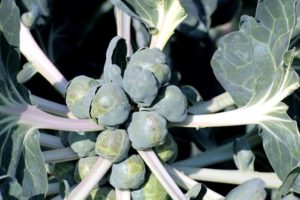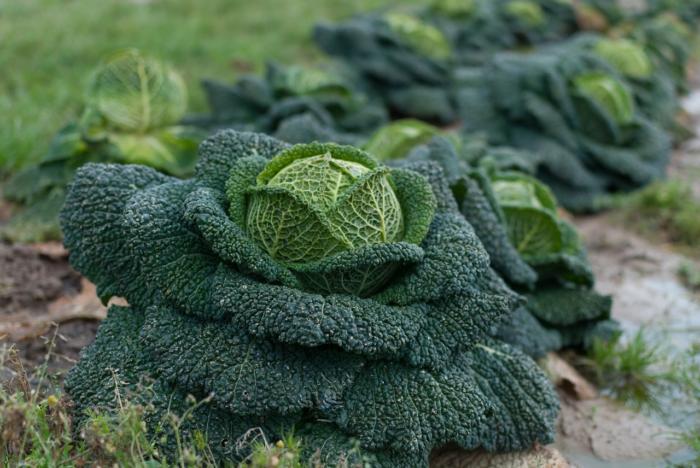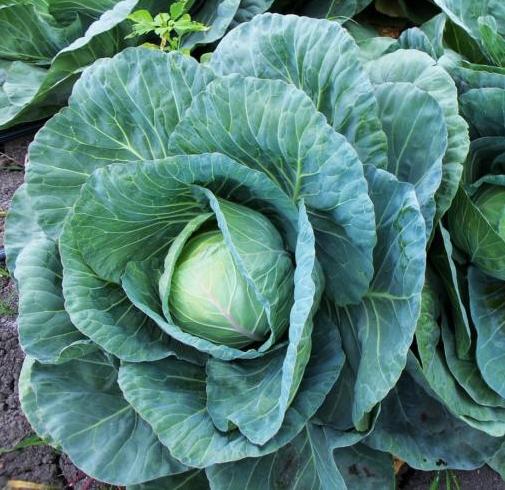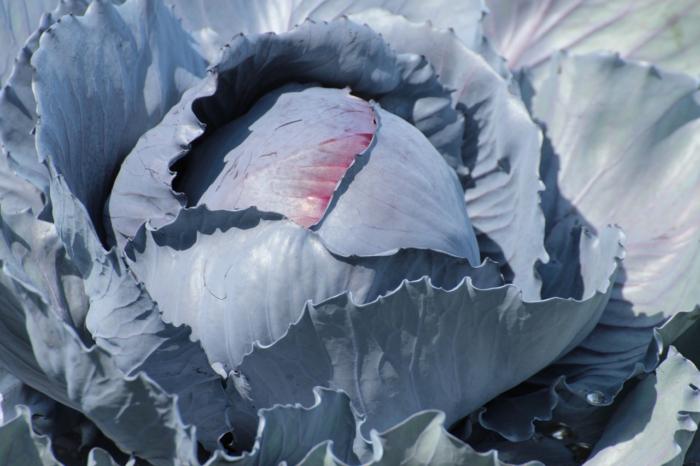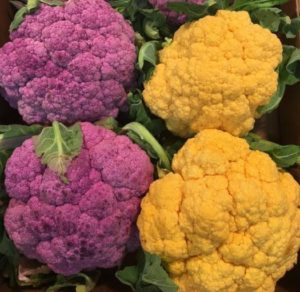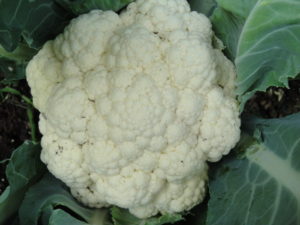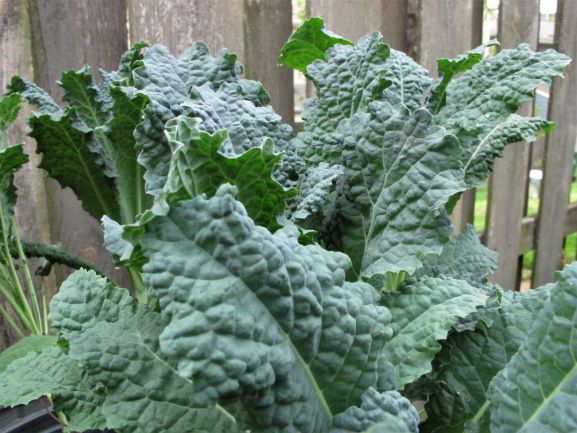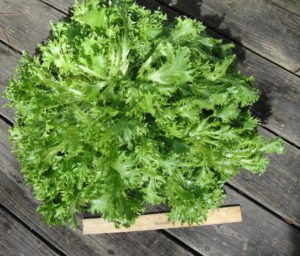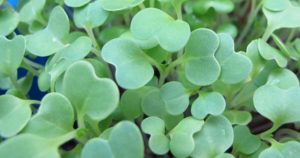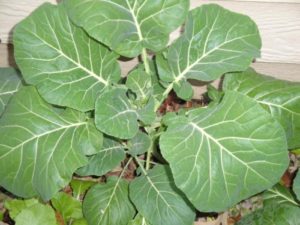Page 2
Brussels Sprouts
Not for the timid, Brussels sprouts is a bit challenging. It requires a long time to grow, as long as 4 months. If I had more space, I’d grow the one called ‘Hestia’, which takes about 3 months to grow. ‘Hestia’ received the AAS Regional Winner Award in recognition of its superior performance in limited regions of the country, namely the Southeast, the Southwest, and the Mountain states.
Give Brussels sprouts plenty of space, about 18-24″ between plants. This vegetable is very cold tolerant, and doesn’t mind the snow. Brussels sprouts can be prepared as a cooked vegetable or raw in Brussels Sprouts Slaw.
All brassicas require moist, rich soil and regular applications of fertilizer. Make sure the product contains a small amount of boron. The pH should be slightly acidic to neutral, so apply ground limestone as recommended by a soil test. Because Brussels sprouts takes a long time to mature, we sometimes forget to fertilize. Adequate nutrients make a huge difference in the performance of the brassicas.
Cabbage
- Savoy cabbage.
- Green cabbage.
- Red cabbage.
I love a bowlful of cool cole slaw in the summer. Shred some cabbage; add diced carrot, sweet pepper, celery, a sprinkle of celery seeds, and your favorite slaw dressing. Done! Cabbage, surprisingly, is high in some B vitamins and Omega-3 fatty acids.
For summer sowing, look for varieties referred to as mid season or storage, most of which require more time to grow than the early varieties. ‘Capture’ is one that I’ve grown for a few years for cole slaw and for rice-stuffed cabbage rolls. It is also disease resistant. ‘Caraflex’ grows a pointed rather than a round head, and is fairly fast growing, maturing in about 65 days. A few newer varieties mature with quite small heads, and are gaining popularity.
Cabbage is available in many forms, from icy blue-green to pink to purple (“red”) leaves, and smooth to savoyed (bumpy, blistered). Nutritionists emphasize consuming colorful (especially red and purple) vegetables for their various phytonutrients. These antioxidants help us in the fight against inflammatory illnesses and cancer.
One spring, I potted up about 10 red cabbage plants into a 12″ pot, with white and lavender alyssum. It was gorgeous! Grown close together, the heads were smaller. A customer bought it as an ornamental plant, and could have harvested the little cabbages, but she kept it for its appearance instead. It lasted for months.
Cauliflower
- Colorful cauliflower.
- Cauliflower from the garden.
There’s a new variety of cauliflower called ‘Flame Star’ that I’d like to try. It’s a soft orange color and easier to grow than ‘Cheddar’, according to the catalog.
The white cauliflower seedlings that I planted last November were not very pretty, but with lots of organic material in the soil and some winter protection, they pulled through a cold winter and provided us with big beautiful heads of cauliflower. When the head started to form, I folded over a few leaves (photo, below), cracking the midrib to keep them in place. This blanches the curd, preventing the white cauliflower from turning green.
Collards
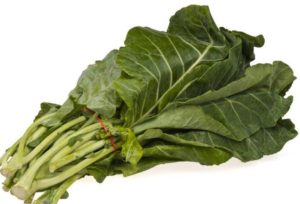
I had never grown collards until I moved to North Carolina. Now it’s a must-have in the fall garden, if only for a big pot of delicious collards soup. Sometimes I add a chopped leaf to other vegetables in our Sunday omelet, or to soups and stir-fries.
Large blue-green leaves are full of vitamins and other nutrients. Pick lower leaves as you need them for the kitchen, and let the plants continue to grow…all the way through winter and into the spring. This is one of the easiest fall greens to grow.
In spring, yellow or white flowers on the biennial brassicas provide nectar and pollen to early foraging bees and beneficial insects.
Collard greens are extremely cold-hardy even into the northern states. It’s another one of those brassicas, like broccoli and kale, ranking as nutrient powerhouses. We eat something from the Brassicaceae family every day. If I miss a day, we make up for it. Just ask Mother.
Kale
‘Red Russian’ and ‘Lacinato’ kales are among our favorite greens for adding to stir-fries, soups, casseroles, pasta dishes, rice dishes, pizza, smoothies, omelets, sauces, and salads. ‘Lacinato’, an Italian heirloom often found on restaurant menus, might be more acceptable to the young ones if you call it by its popular name, “Dinosaur Kale”. You might see it listed in catalogs as ‘Toscano’ or Tuscan kale (photo, above). The thickest midribs can be a little tough, so I remove them before cooking. You could cook them longer in soup, for example, to soften them.
‘Lacinato’ and ‘Red Russian’ kale are two of the most versatile of the cool season greens to grow. Easy from seed and often available in garden centers and farmers’ markets, beginning gardeners might start with these. Their leaves wilt readily in cooking and are more tender than the curly-leaved kales.
‘Prizm’ is a new variety and an All-America Selections Winner. It’s a curly leaf variety, described as being tender enough for a raw salad.
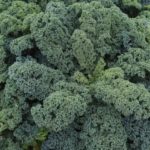
Curly leaf kale.
Because of kale’s concentration and variety of vitamins, minerals, and phytonutrients, we rank it high on the list of “super-foods”. In fact, it is so high in Vitamin K that it’s wise to consult with your doctor before eating much of it if you take blood-thinning medications.
Another issue concerns people low in iodine and eating large quantities of raw brassicas, especially mustard greens. This can cause a disruption in thyroid function.
Lettuce
Lettuce comes in a diverse array of taste, texture, weight, and color. There are loose-leaf lettuces, and oakleafs, Romaines, butterheads, Bibbs, Batavians, and icebergs, miniatures and full-size heads.
Johnny’s Selected Seeds‘ catalog has a handy seasonal chart listing varieties that are appropriate for early, mid, and late season growing. ‘Muir’, ‘Green Star’, ‘Sparx’, and ‘Skyphos’ are are among the heat-tolerant types, especially when used with shade fabric. Since I have most of these seeds, I’ll be starting those first.
Several other lettuces will be sown in cooler weather, and I plan to use cold frames again for a winter-long harvest of greens. Johnny’s exclusive listing of the ‘Salanova’ series (photo, right) includes 8 varieties, with the ‘Incised’ and ‘Sweet Crisp’ types making large, full heads.
John Scheepers includes in its catalog several varieties that I grew in the Maryland garden. French heirlooms ‘Rouge d’Hiver’ and ‘Merveille des Quatre Saisons’ are some of my favorites. They also carry ‘Red Salad Bowl’, the ‘Lolla’ types, 150-year-old ‘Black Seeded Simpson’, and dozens more. All good!
There must be a hundred readily available lettuce varieties, and I encourage you to experiment with some new ones every year. Keep notes, and compose a list of family favorites. Take note of the varieties that taste good in warm weather. (‘Skyphos’ is one of my favorites for flavor even into early summer.) Another source of quality seeds is Botanical Interests.
Lettuce Mixes
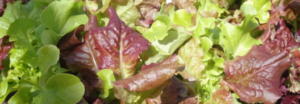
Allstar Gourmet Lettuce Mix, from Johnny’s, is a mixture of textures and colors.
There are mixes of mostly leaf lettuces you can grow. Burpee Seeds‘ Heatwave Blend (which includes some head lettuces) and Gourmet Blend, and Johnny’s’ Allstar Gourmet Lettuce Mix (photo, above) have several colorful varieties in their mixtures.
Lettuce needs moist, enriched soil with pH near neutral (6.0 to 7.0). If the pH is 6.0 or lower, lime the soil to raise the pH. Adequate calcium in the soil helps prevent tipburn on the leaf edges.
Watch carefully for slugs and aphids; they can easily escape notice when harvesting. Slugs are not only unappetizing, but can also be harmful to your health!
Nutritional Considerations of Fall Greens
All the fall greens listed above, except lettuce, are members of the family Brassicaceae. Most belong to only a couple of species, Brassica oleracea and B. rapa. Variety names distinguish particular types of plants, such as Brussels sprouts (Brassica oleracea var. gemmifera) and cabbage (Brassica oleracea var. capitata). Arugula’s botanical name is Eruca sativa. Seed catalogs list dozens more of the brassicas.
Brassicas contain an astonishing assortment of vitamins, minerals, fiber, protein, and phytonutrients. Consuming these crops fresh from the garden preserves more nutrients. After a day or two, the enzyme content starts to diminish, losing the ability to convert phytonutrients, such as various types of glucosinolates, into isothiocyanates.
These antioxidants are powerful assistants in the fight against several forms of cancer, particularly those that affect the alimentary canal. Microgreens (photo, above), young plants harvested just a few weeks after sowing, have many times more nutrients than the mature crops, ounce for ounce.
Consumption of raw produce from this group helps different parts of the body than cooked greens do, so it’s a good idea to eat them in both raw and cooked forms. Avoid overcooking brassicas or cooking at high temperatures because of the damage it causes their vitamins and enzymes. Eat them as fresh as you possibly can, and sometimes raw.
Where’s the Beef?
Many claim that red meat is necessary to get enough protein, but let me reassure you that some of the brassicas provide a surprising amount. Broccoli contains 2/3 the amount of protein, calorie for calorie, found in chicken! And collard greens are not far behind. Granted, 100 calories of chicken will fit in the palm of your hand, while it might take 2 or 3 handfuls of broccoli to add up to the same 100 calories. This is good news for vegetarians.
By doing research on each of the nutrients we need in our diets, you can find a vegetarian alternative out there. A notable exception is Vitamin B12, which is necessary for heart health. Only animal products contain this vitamin, with smaller quantities in milk and eggs. The only plant products that contain Vitamin B12 are fortified cereals. Consult with a nutritionist or go online to reputable sites for the latest information.
Only the Beginning
Check the catalogs and seed racks at your local garden centers for more fall greens and vegetables to try. Add leeks, peas, garlic, spinach, green onions, and Swiss Chard to the list. Don’t forget the Asian greens, and the root crops, such as radish, carrot, and beets.
For now, think about the fall greens and vegetables you want to grow, and bring in the supplies. Start preparing the soil today! And enjoy those summer vegetables, too. For us, it’s salad for dinner tonight…with arugula. Happy gardening!
Page 1: Ready To Sow Fall Greens and Vegetables?, If They Can’t Take the Heat (Choosing Varieties of Fall Greens), Planting Young Transplants (Soil, Roots, To Bury Or Not To Bury?, Fertilizer), Arugula, Broccoli, and Miniature Broccoli ‘Happy Rich’ (Bt)
Page 2: Brussels Sprouts, Cabbage, Cauliflower, Collards, Kale, Lettuce, Nutritional Considerations of Fall Greens (Where’s the Beef?), and Only the Beginning
